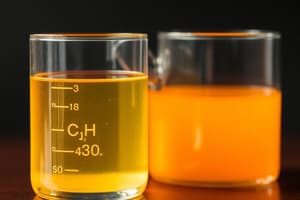Podcast
Questions and Answers
What is the defining characteristic of acids according to the Bronsted-Lowry concept?
What is the defining characteristic of acids according to the Bronsted-Lowry concept?
- Proton donors (correct)
- Proton acceptors
- Salt formers
- Neutralizers
Which of the following compounds is classified as a Bronsted-Lowry acid?
Which of the following compounds is classified as a Bronsted-Lowry acid?
- Water (H2O)
- Sulfuric acid (H2SO4) (correct)
- Ammonia (NH3)
- Ethanol (C2H5OH)
What is the expected product when an acid and a base react in a neutralization reaction?
What is the expected product when an acid and a base react in a neutralization reaction?
- Chlorine gas (Cl2)
- Salt and water (H2O) (correct)
- Carbon dioxide (CO2)
- Hydrogen gas (H2)
In an acid-base reaction, which molecule gains a proton to become a conjugate acid?
In an acid-base reaction, which molecule gains a proton to become a conjugate acid?
What role do conjugate acid-base pairs play in acid-base reactions?
What role do conjugate acid-base pairs play in acid-base reactions?
Which compound serves as an example of a Bronsted-Lowry base?
Which compound serves as an example of a Bronsted-Lowry base?
What is the role of hydrochloric acid (HCl) in the reaction with sodium hydroxide (NaOH)?
What is the role of hydrochloric acid (HCl) in the reaction with sodium hydroxide (NaOH)?
Which compound represents a conjugate pair in the reaction of HCl with NaOH?
Which compound represents a conjugate pair in the reaction of HCl with NaOH?
What differentiates strong acids from weak acids in solution?
What differentiates strong acids from weak acids in solution?
Why does a low concentration of hydrogen ions indicate the presence of a weak acid?
Why does a low concentration of hydrogen ions indicate the presence of a weak acid?
Which compound is an example of a strong base?
Which compound is an example of a strong base?
How does the equilibrium constant (Keq) provide valuable information in acid-base reactions?
How does the equilibrium constant (Keq) provide valuable information in acid-base reactions?
Flashcards are hidden until you start studying
Study Notes
Acid-Base Reactions in Chemistry II
Acid-base reactions are a fundamental aspect of chemistry, playing a crucial role in various chemical processes and reactions. These reactions involve the transfer of a proton (H+) from one molecule (acid) to another (base), leading to the formation of a conjugate acid-base pair. Understanding acid-base reactions is essential for comprehending numerous chemical phenomena and predicting the outcomes of chemical reactions.
Bronsted-Lowry Acids and Bases
According to the Bronsted-Lowry concept, acids are defined as proton donors, while bases are proton acceptors. This definition allows us to categorize different compounds into acids or bases depending on their ability to donate or accept protons. Examples of Bronsted-Lowry acids include hydrochloric acid (HCl) and sulfuric acid (H2SO4), while examples of Bronsted-Lowry bases include ammonia (NH3) and ethanol (C2H5OH).
Neutralization Reactions
When an acid and a base react, the result is typically a neutralization reaction, where both the acid and the base are converted into their respective salts and water (H2O). This process involves the loss of a proton by the acid, leading to the formation of a conjugate base, while the base gains a proton, forming a conjugate acid. For example, when hydrochloric acid (HCl) reacts with sodium hydroxide (NaOH), the reaction proceeds as follows:
HCl + NaOH → NaCl + H2O
In this reaction, HCl acts as a Bronsted-Lowry acid, donating a proton to NaOH, which acts as a Bronsted-Lowry base, accepting the proton. The products are sodium chloride (NaCl) and water (H2O), with each compound representing a conjugate pair.
Strong and Weak Acids and Bases
Strong acids and bases completely dissociate in solution, while weak acids and bases partially dissociate. Strong acids release all of their protons into solution, while weak acids release only a fraction of their protons. Similarly, strong bases fully deprotonate in solution, while weak bases only partially do so. Common examples of strong acids include hydrochloric acid (HCl) and sulfuric acid (H2SO4), while common strong bases include sodium hydroxide (NaOH) and potassium hydroxide (KOH).
pH and Equilibrium Constants
The concentration of hydrogen ions (pH) in a solution plays a significant role in determining whether an acid is strong or weak. The higher the concentration of hydrogen ions, the lower the pH value, indicating the presence of a strong acid. On the other hand, a low concentration of hydrogen ions indicates the presence of a weak acid. The equilibrium constant (Keq) of an acid-base reaction provides valuable information about the reaction's position in terms of forward vs. reverse directions.
Conclusion
Understanding acid-base reactions is crucial for navigating the world of chemistry. By studying the principles behind acid-base reactions, chemists can develop a solid foundation for predicting the outcomes of various reactions and designing new chemical compounds. As we continue our exploration of Chemistry II, we will delve deeper into the fascinating realm of chemical reactions, equipping ourselves with the necessary knowledge to tackle complex problems and contribute meaningfully to scientific advancements.
Studying That Suits You
Use AI to generate personalized quizzes and flashcards to suit your learning preferences.




